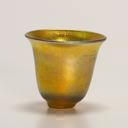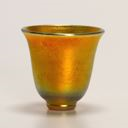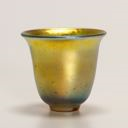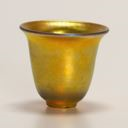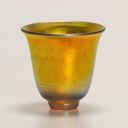Steuben Glass, inc.
American
(active 1903 - 2011)
Frederick Carder was born on September 18, 1863 in an industrial district of Staffordshire, England.(1) Though he did well in school, Carder was short-tempered and easily frustrated by the routine. At the age of 14, he quit school and began work as a coal shoveler at Leys Pottery, which was owned by his father and paternal grandfather. Though he soon regretted his decision to leave school, Carder persevered, and was eventually transferred to the pottery's finishing room. He resumed his schoolwork, taking night classes in metallurgy, chemistry, and electricity at Dudley Mechanics Institute, and drawing and design classes at the School of Art in Stourbridge. Carder's grandfather encouraged his interest in pottery and allowed Carder to experiment with a variety of clays as well as glazing and firing techniques. In 1878, however, Carder's grandfather died and the factory came under the control of Carder's father and uncles who were less supportive of his interests and experiments. One uncle was particularly hostile to Carder's ideas and Carder eventually decided to leave the pottery. Carder had been taking lessons in cameo glassmaking and marble carving from the glassmaker, John Northwood. Northwood recommended him to the Brierley Hill firm of Stevens and Williams, who were looking for a glass designer, and Carder began working for them in 1880.
Stevens and Williams specialized in cut crystal art glass; during his first year with the company, Carder served as an apprentice, copying new designs to scale and designing glass forms. Carder, however, was interested in more challenging work, namely the production of colored glass. He persuaded the head of the factory to let him produce and market some trial pieces and their success resulted in greater design freedom for Carder. In addition to Carder's colored glass pieces, the factory also began producing cameo glass on a large scale during this period and Carder participated in this new venture as well. Carder's energy was boundless. In addition to his duties as glassmaker, he designed new product lines, and worked as an international salesman for the company. He also continued to work evenings at the pottery, modeling sculptures and relief panels in terra-cotta. When Carder's teacher and friend, John Northwood, was hired as art director, they collaborated on a variety of new products and designs.
Carder's personal life also was eventful during this period. He was married to Annie Walker in May of 1887 and his work began to acquire a national reputation around the same time. In 1888, he won a silver medal in the National Competition of Schools of Science and Art for vase design and was awarded a gold medal in the same competition the following year. In 1891, he won an Art Master's Certificate and a Gold Medal of the Year at national art competitions in London, and was asked to establish an art school in his hometown (Wordsley) for talented workmen. In 1893, one of his pieces was accepted for the Exhibition of the Royal Academy of Arts. His crowning glory was the offer of a three year scholarship to study in Europe. Unfortunately, Stevens and Williams would not release Carder from his contract or grant him leave, and he was forced to give up the opportunity. The scholarship committee was, however, eventually able to award Carder some of the funds by sponsoring the study trips he took during his annual vacations to glass collections in England and Europe. To further these studies, in 1902, Stevens and Williams also sent Carder on a tour of glassmaking centers in Germany and Austria and in 1903 he sailed for the United States.
Soon after his arrival in America, Carder announced that he was to be co-founder and manager of a new concern in New York, Steuben Glass Works, in partnership with a man called Thomas G. Hawkes. The speed of the announcement suggests that Carder may have been negotiating with Hawkes, with whom he was already acquainted, long before he left England. Regardless, things moved swiftly, and by late that year Carder had relocated to Corning, New York and the new factory had begun production. The factory's primary responsibility was to supply Hawkes with glass blanks for decoration. With Carder as manager, however, the plant was soon producing a variety of colored and opaque glass items as well. The business grew steadily during the first fifteen years, reaching its height in the years just before WWI. During this productive period, Carder experimented with an enormous variety of glass designs from cameo-carved figural glass to etched glass. He also invented several new varieties of glass among which were his Verre de Soie (transparent glass with an iridescent surface), Calcite (creamy-white glass with an ivory translucence) and the widely popular Aurene, an iridescent glass that came in blue and gold.(2) Aurene became so popular that it began to threaten the market ascendance of Tiffany Glass and Tiffany sued Steuben in 1913, claiming that the techniques for producing Aurene had been stolen from the Tiffany workrooms. The case was eventually dismissed for lack of evidence.
The Steuben company's prosperity came to an end with WWI. The industry was considered nonessential to the war effort, and due to materials shortages, was closed in 1918. Carder was forced to sell his holdings in Steuben and the firm was acquired by Corning Glass Works, becoming the Steuben Division of that company. Carder was named managing director of the new division, and once production resumed after the war, began to produce his colored glass once again. In the late 1920s, however, sales of Steuben glass began to fall, partly as a result of the reduced demand for expensive collectibles after the stock market crash, but primarily as a result of changing tastes. Functional and modern designs were preferred to the elaborate Art Deco styles popular before the war and clear glass had become more popular than colored. Carder was ordered to discontinue many traditional forms and introduce designs by artists who were more contemporary. He resisted these changes, however, and in 1932 he was transferred out of the Steuben division and replaced by a more cooperative manager. In 1933, further heralding a new regime at Steuben, Arthur Amory Houghton, Jr., great-grandson of the founder of Corning Glass Works, took over the Steuben Division and decided to produce only clear crystal glass.
Understandably, Carder at first believed his glassmaking career had ended. He rallied, however, and decided to make the most of his new position as art manager of the Corning Glass Works. He began to experiment with glassmaking processes such as cire perdue (lost wax) casting, and the production of decorative architectural glass, such as the sculptured glass panels he created for the RCA Building in Rockefeller Center. He also designed and carved plaster models and drew designs for other divisions of Corning Glass Works. Until his retirement in 1959, at the age of 96, Carder continued to work full-time at his factory studio.
Carder also was an active member of his community. He was a member of the Advisory Committee of the Metropolitan Museum of Art for many years, a fellow of the Royal Society of Arts in London, and a member of the American Association for the Advancement of Science and Art. He founded the Corning Rotary Club and served as its first president, served as president of the Corning City Club, and helped to establish the Corning Country Club. He also served on the Board of Education for 30 years, including several years as its president, and in gratitude for his years of service the local school district named one of its elementary schools after him. He died at the age of 100, in December, 1963.
Carder's designs for Steuben can be found in many well-known decorative art collections including the Metropolitan Museum of Art, the Victoria and Albert Museum, London and the Louvre, Paris. One of the most extensive and comprehensive collections of Carder's work is located at the Rockwell Museum in Corning, New York. Robert Rockwell assembled the collection with the aid and supervision of Carder himself.(3)
Carder's style is characterized by variety and eclecticism. Throughout his career, he remained a student of glass in all its varieties, through time and throughout the world. He was always aware of the work of his contemporaries, responding and reacting to it. Carder also was not afraid to experiment with new glass chemistries and was able to reproduce both the glass mixtures and techniques of ancient glass artisans and generate new designs based on his discoveries. He loved to work with color and pattern; plain, clear glass pieces are rare in his oeuvre.
(1)E. M. Elville, The Collector's Dictionary of Glass, Country Life Limited, London, 1961, reprinted 1965, 1967; The Story of Steuben Glass, Steuben Glass, New York, 1962; Robert F. Rockwell, Frederick Carder and His Steuben Glass, 1903-1933 , Dexter Press, West Nyack, New York, 1968; Paul V. Gardner, The Glass of Frederic Carder, Crown Publishers, Inc., New York, 1971; Emma Papert, The Illustrated Guide to American Glass, Hawthorn Books, Inc., New York, 1972, pp. 247-251; Paul N. Perrot, Paul V. Gardner, and James S. Plaut, Steuben: Seventy Years of American Glassmaking, Praeger Publishers, New York, 1974; John Fleming and Hugh Honour, Penguin Dictionary of Decorative Arts, Viking Press, 1989, pp. 153, 779; Nancy O. Merrill, A Concise History of Glass Represented in the Chrysler Museum Glass Collection, The Chrysler Museum, Norfolk, Virginia, 1989, pp. 162-163; information on file at the Montgomery Museum of Fine Arts, October, 1996
(2)Papert, 1972, p. 247. "Carder's most famous glass was Aurene, made in either iridescent blue or iridescent gold, its brilliant surface obtained from the use of glass containing metallic salts which were precipitated to the surface when heated in a special atmosphere. This was later sprayed with a metal chloride solution which drew the surface into an infinite number of fine lines, having great powers of reflection."
(3)For a history of the collection's development see Robert F. Rockwell, Frederick Carder and His Steuben Glass, 1903-1933 , 1968, Dexter Press, West Nyack, New York
M. Bullock 10/17/96
American
(active 1903 - 2011)
Frederick Carder was born on September 18, 1863 in an industrial district of Staffordshire, England.(1) Though he did well in school, Carder was short-tempered and easily frustrated by the routine. At the age of 14, he quit school and began work as a coal shoveler at Leys Pottery, which was owned by his father and paternal grandfather. Though he soon regretted his decision to leave school, Carder persevered, and was eventually transferred to the pottery's finishing room. He resumed his schoolwork, taking night classes in metallurgy, chemistry, and electricity at Dudley Mechanics Institute, and drawing and design classes at the School of Art in Stourbridge. Carder's grandfather encouraged his interest in pottery and allowed Carder to experiment with a variety of clays as well as glazing and firing techniques. In 1878, however, Carder's grandfather died and the factory came under the control of Carder's father and uncles who were less supportive of his interests and experiments. One uncle was particularly hostile to Carder's ideas and Carder eventually decided to leave the pottery. Carder had been taking lessons in cameo glassmaking and marble carving from the glassmaker, John Northwood. Northwood recommended him to the Brierley Hill firm of Stevens and Williams, who were looking for a glass designer, and Carder began working for them in 1880.
Stevens and Williams specialized in cut crystal art glass; during his first year with the company, Carder served as an apprentice, copying new designs to scale and designing glass forms. Carder, however, was interested in more challenging work, namely the production of colored glass. He persuaded the head of the factory to let him produce and market some trial pieces and their success resulted in greater design freedom for Carder. In addition to Carder's colored glass pieces, the factory also began producing cameo glass on a large scale during this period and Carder participated in this new venture as well. Carder's energy was boundless. In addition to his duties as glassmaker, he designed new product lines, and worked as an international salesman for the company. He also continued to work evenings at the pottery, modeling sculptures and relief panels in terra-cotta. When Carder's teacher and friend, John Northwood, was hired as art director, they collaborated on a variety of new products and designs.
Carder's personal life also was eventful during this period. He was married to Annie Walker in May of 1887 and his work began to acquire a national reputation around the same time. In 1888, he won a silver medal in the National Competition of Schools of Science and Art for vase design and was awarded a gold medal in the same competition the following year. In 1891, he won an Art Master's Certificate and a Gold Medal of the Year at national art competitions in London, and was asked to establish an art school in his hometown (Wordsley) for talented workmen. In 1893, one of his pieces was accepted for the Exhibition of the Royal Academy of Arts. His crowning glory was the offer of a three year scholarship to study in Europe. Unfortunately, Stevens and Williams would not release Carder from his contract or grant him leave, and he was forced to give up the opportunity. The scholarship committee was, however, eventually able to award Carder some of the funds by sponsoring the study trips he took during his annual vacations to glass collections in England and Europe. To further these studies, in 1902, Stevens and Williams also sent Carder on a tour of glassmaking centers in Germany and Austria and in 1903 he sailed for the United States.
Soon after his arrival in America, Carder announced that he was to be co-founder and manager of a new concern in New York, Steuben Glass Works, in partnership with a man called Thomas G. Hawkes. The speed of the announcement suggests that Carder may have been negotiating with Hawkes, with whom he was already acquainted, long before he left England. Regardless, things moved swiftly, and by late that year Carder had relocated to Corning, New York and the new factory had begun production. The factory's primary responsibility was to supply Hawkes with glass blanks for decoration. With Carder as manager, however, the plant was soon producing a variety of colored and opaque glass items as well. The business grew steadily during the first fifteen years, reaching its height in the years just before WWI. During this productive period, Carder experimented with an enormous variety of glass designs from cameo-carved figural glass to etched glass. He also invented several new varieties of glass among which were his Verre de Soie (transparent glass with an iridescent surface), Calcite (creamy-white glass with an ivory translucence) and the widely popular Aurene, an iridescent glass that came in blue and gold.(2) Aurene became so popular that it began to threaten the market ascendance of Tiffany Glass and Tiffany sued Steuben in 1913, claiming that the techniques for producing Aurene had been stolen from the Tiffany workrooms. The case was eventually dismissed for lack of evidence.
The Steuben company's prosperity came to an end with WWI. The industry was considered nonessential to the war effort, and due to materials shortages, was closed in 1918. Carder was forced to sell his holdings in Steuben and the firm was acquired by Corning Glass Works, becoming the Steuben Division of that company. Carder was named managing director of the new division, and once production resumed after the war, began to produce his colored glass once again. In the late 1920s, however, sales of Steuben glass began to fall, partly as a result of the reduced demand for expensive collectibles after the stock market crash, but primarily as a result of changing tastes. Functional and modern designs were preferred to the elaborate Art Deco styles popular before the war and clear glass had become more popular than colored. Carder was ordered to discontinue many traditional forms and introduce designs by artists who were more contemporary. He resisted these changes, however, and in 1932 he was transferred out of the Steuben division and replaced by a more cooperative manager. In 1933, further heralding a new regime at Steuben, Arthur Amory Houghton, Jr., great-grandson of the founder of Corning Glass Works, took over the Steuben Division and decided to produce only clear crystal glass.
Understandably, Carder at first believed his glassmaking career had ended. He rallied, however, and decided to make the most of his new position as art manager of the Corning Glass Works. He began to experiment with glassmaking processes such as cire perdue (lost wax) casting, and the production of decorative architectural glass, such as the sculptured glass panels he created for the RCA Building in Rockefeller Center. He also designed and carved plaster models and drew designs for other divisions of Corning Glass Works. Until his retirement in 1959, at the age of 96, Carder continued to work full-time at his factory studio.
Carder also was an active member of his community. He was a member of the Advisory Committee of the Metropolitan Museum of Art for many years, a fellow of the Royal Society of Arts in London, and a member of the American Association for the Advancement of Science and Art. He founded the Corning Rotary Club and served as its first president, served as president of the Corning City Club, and helped to establish the Corning Country Club. He also served on the Board of Education for 30 years, including several years as its president, and in gratitude for his years of service the local school district named one of its elementary schools after him. He died at the age of 100, in December, 1963.
Carder's designs for Steuben can be found in many well-known decorative art collections including the Metropolitan Museum of Art, the Victoria and Albert Museum, London and the Louvre, Paris. One of the most extensive and comprehensive collections of Carder's work is located at the Rockwell Museum in Corning, New York. Robert Rockwell assembled the collection with the aid and supervision of Carder himself.(3)
Carder's style is characterized by variety and eclecticism. Throughout his career, he remained a student of glass in all its varieties, through time and throughout the world. He was always aware of the work of his contemporaries, responding and reacting to it. Carder also was not afraid to experiment with new glass chemistries and was able to reproduce both the glass mixtures and techniques of ancient glass artisans and generate new designs based on his discoveries. He loved to work with color and pattern; plain, clear glass pieces are rare in his oeuvre.
(1)E. M. Elville, The Collector's Dictionary of Glass, Country Life Limited, London, 1961, reprinted 1965, 1967; The Story of Steuben Glass, Steuben Glass, New York, 1962; Robert F. Rockwell, Frederick Carder and His Steuben Glass, 1903-1933 , Dexter Press, West Nyack, New York, 1968; Paul V. Gardner, The Glass of Frederic Carder, Crown Publishers, Inc., New York, 1971; Emma Papert, The Illustrated Guide to American Glass, Hawthorn Books, Inc., New York, 1972, pp. 247-251; Paul N. Perrot, Paul V. Gardner, and James S. Plaut, Steuben: Seventy Years of American Glassmaking, Praeger Publishers, New York, 1974; John Fleming and Hugh Honour, Penguin Dictionary of Decorative Arts, Viking Press, 1989, pp. 153, 779; Nancy O. Merrill, A Concise History of Glass Represented in the Chrysler Museum Glass Collection, The Chrysler Museum, Norfolk, Virginia, 1989, pp. 162-163; information on file at the Montgomery Museum of Fine Arts, October, 1996
(2)Papert, 1972, p. 247. "Carder's most famous glass was Aurene, made in either iridescent blue or iridescent gold, its brilliant surface obtained from the use of glass containing metallic salts which were precipitated to the surface when heated in a special atmosphere. This was later sprayed with a metal chloride solution which drew the surface into an infinite number of fine lines, having great powers of reflection."
(3)For a history of the collection's development see Robert F. Rockwell, Frederick Carder and His Steuben Glass, 1903-1933 , 1968, Dexter Press, West Nyack, New York
M. Bullock 10/17/96
